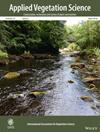Measuring plant functional specialization in urban environments with Grime's CSR strategies
Abstract
Question
Specialization refers to the degree of niche breadth of a species. Generalist species are able to persist in a broad range of habitats, whereas specialist species are adapted to a restricted range of environmental conditions. Cities host a great heterogeneity of habitats with variable degrees of human impact. This is generally reflected in the functional composition of the urban floras. The aim of our study is thus to explore whether the degree of functional specialization of urban plant assemblages varies among habitats subject to different degrees of human impact and disturbance regimes.
Location
Thirty-two cities in Central Europe with more than 100,000 inhabitants.
Methods
We used a data set containing plots of urban floras sampled in seven habitat types within each city: historical city square, boulevard, residential area with a compact building pattern, residential area with an open building pattern, city park, early successional site, and mid-successional site. These habitats differ in the level of human impact, ranging from moderately urbanized suburban habitats to the most urbanized habitats in the city center. For each plot, we calculated a recently introduced specialization index, which is based on the application of concentration measures to Grime's community-level mean CSR strategies.
Results
Along the urbanization gradient, from peripheral to central habitats, we observed a marked intensification in the degree of functional specialization of urban habitats, which is primarily attributable to an increase in the selection of ruderal species.
Conclusions
Urban ecosystems are characterized by a wide variety of human impacts that affect the functioning of the resident species. Considering cities as heterogeneous systems is thus of paramount importance for understanding the mechanisms that drive the assembly of urban floras.


 求助内容:
求助内容: 应助结果提醒方式:
应助结果提醒方式:


